False Sunni-Shia binary on Yemen in mainstream media – Abubakr Al-Shamahi
About the author: Abubakr Al-Shamahi is a British–Yemeni freelance journalist. He holds an MA in Near and Middle Eastern Studies from SOAS, University of London. Abubakr tweets at @abubakrabdullah. His blog can be found at www.alshamahi.com. The following article, cross-posted from Yemen Times, has been lightly edited and adapted in view of recent developments. Additional information has been provided by Sarah Khan.
**************
Yemen is more nuanced than Sunni and Shia
Religion, just like most things in Yemen, is often confusing to the outside observer.
Those with a passing interest in the Middle East will generally know of the main schism in Islam, that between Shias and Sunnis. The conflicts we see in the Middle East today, whether they be in Syria, Iraq, Bahrain or Lebanon, are often largely framed in the manner of disputes between adherents of Shiism and Sunnism. Sometimes, it is even portrayed as the continuation of a 1400 year old ‘war for Islam’, which is useful for anyone trying to whitewash the role of colonialism and little things like the Iraq War—they’d have been killing each other anyway!
Enter Yemen. In the north of the country, a group known as the Houthis, but also now known as Ansar Allah, variously described as ‘Zaydi Revivalists’, ‘Shia militants’ and ‘pro-Iranian fighters’, have been fighting with what seems like just about everyone over the last ten years. They’ve taken on the Yemeni state in 6 wars starting in 2004, fought Yemeni and foreign Salafis (or Wahhabis), skirmished with the Saudi army, and most recently battled with the al-Ahmars, the leaders of Yemen’s most powerful tribal confederation, Hashid.
Kudos to them, they’ve performed relatively successfully, and now sit in an enviable position, largely controlling the areas lying between the Yemeni capital Sana’a and the Saudi border.
Who are they? Well, calling them ‘Shia’, ‘Zaydi’ and ‘pro-Iranian’ always lack nuance, and some understanding of the Yemeni situation. The Sunni-Shia or Saudi-Iran binary lacks nuance and also helps the Saudi media to implement its specific Salafist and regional agenda by portraying Houthis as Shias or Iranian proxies. It must be born in mind that from a Saudi Salafi perspective all Shias despite their Arab origins are stereotyped as Iranian or Persian proxies.
So Yemen’s religious make-up. The two main ‘religious groups’ to start with here are Zaydis and Shafi’is.
Zaydism (Zaydiyyah) is a school of thought within Shia Islam but is closer to Sunni Islam in many ways than the mainstram Isna Ashri Shias. Zaydism is named after Imam Zaydi Bin Ali, who was killed in an uprising against the Ummayyads. Although it was once found in places such as Iran and North Africa, Zaydis are now only found in significant numbers in Yemen. A Zaydi Imamate ruled many part of northern Yemen for 1000 years, up until the last Imam was overthrown in 1962. Traditionally, places like Sana’a, Dhamar, Hajja and Amran are Zaydi, and the heartland is Sa’dah. A common saying referring to the Zaydis is that they are “the Sunnis of the Shia, and the Shia of the Sunnis”, indicating that there is not a huge difference doctrinally between Zaydis and Sunnis (or at least it has been perceived that way).
Shafi’ism (Shafi’iyyah) is a school of thought within Sunni Islam. It is named after Imam al-Shafi’i, and is one of the four main schools of thought in Sunni Islam. Shafi’is are found across the Muslim world, such as Egypt, Syria, Indonesia and Somalia. In Yemen, Shafi’is predominate in all the areas not mentioned as being ‘traditionally’ Zaydi, and they are the majority particularly in the Soutern part of Yemen. However, some have old grievances regarding the way that the ruling class of northern Yemen during the Imamate was Zaydi.
Now, the important thing to note here, and this might sound suspicious to people looking at the rest of the Middle East, Zaydis and Shafi’is have traditionally gotten along just fine. For example, although a mosque may be affiliated to one group or the other, no one will bat an eyelid if a person from another sect comes in to pray, and people pray together. The only difference you’ll notice is that some people pray with their hands to the sides (Zaydis) and others with their hands folded (Shafi’is). An example—my local mosque’s Friday sermon is delivered by an Egyptian sheikh from al-Azhar (a Sunni), the Zaydi call to prayer is given, the Imam leading the prayer is Zaydi, and the congregation is evenly split. My own family are split between Zaydis and Shafi’is, and those that prefer to call themselves just Muslim and leave the details to one side. And all was good…
Well, until politics got involved.
What we’re seeing in northern Yemen today, in terms of fighting between the Houthis on one side, and various armed groups on the other, definitely does have an element of the sectarianism that can be seen across the wider region. However, it’s a lot more confusing. For one, it’s wrong to simply say that Houthis = Zaydis, and, say, Al-Ahmar = Shafi’is. Or even worse, Houthis = Shias, and al-Ahmar = Sunnis. For one, the al-Ahmars are traditionally Zaydi, just like the Houthis. I can’t vouch for the religious identification of each individual Ahmar, but I’d say that many of their tribal fighters will still, at least loosely, identify as Zaydi. Ali Abdullah Saleh, who fought 6 wars against the Houthis, was also Zaydi. So is this Zaydi on Zaydi fighting? A Zaydi civil war?
Well, no. To put it very simply, you can say that the religious element behind the Houthis, i.e., Zaydism, is revived by decaded of oppression by the Yemeni government on one side and the onslaught of Saudi-backed Salafi evangelists and Al-Qaeda on the other. There is a feeling that their rights a equal citizen of the state have been violated not only in socio-economic and political terms but also there is a sense of ideological suppression. I was told by a Houthi that I met in Sa’dah that “the Zaydis in Sana’a have forgotten how to be Zaydi.” Many Houthis believe that they are reviving Zaydi traditions and beliefs, that have been suppressed in the years following the 1962 revolution (despite all presidents of North Yemen in that period having been Zaydi). They see people like Saleh and the al-Ahmars as Zaydi in name only.
On the other side, the al-Ahmars, and Saleh in the past, have accused the Houthis of secretly not being Zaydi anymore, and instead being Twelver Shias (a la Iran). This then easily feeds into the wider paranoia, and the Saudi-GCC discourse, which is also conveniently parroted in the Western media, about the spread of Shi’ism and Iranian power in the region. Although there are Twelvers who are Houthis, and some of them are newly ‘converted’, the vast majority of Houthis would still self-identify as Zaydi.
To further complicate things, many of the al-Ahmars are members of the Islah Party. The al-Ahmar Godfather, Sheikh Abdullah al-Ahmar, was the head of the Islah Party. Now, Islah are commonly known in Yemen to be the ‘Muslim Brotherhood’ party. A Muslim Brotherhood group that is led by a Shia? Absurd. But one led by a ‘Zaydi’? Or at least one who isn’t that doctrinally strict? Not so absurd. And by painting the Houthis as ‘Twelvers’, it is easy for Islah/Ahmars to paint themselves as the defenders of Yemen (and Zaydism) against foreign ideas.
It’s complicated, is the best way to put it, and to really understand the nuances of the Yemeni religious scene you need to have studied all the different religious schools for years, and then the politics on top of that. Just remember, it might be tempting to simply use the Sunni-Shia or Iran-Saudi binary, but any analysis that simply looks at it through that prism is bound to be extremely lacking. Such a flawed discourse adds to the miseries of common Sunni and Shia Muslims of Yemen as both groups continue to suffer at the hands of Al-Qaeda (Takfiris) and Salafis.
************
Appendix:
A Bloody Conundrum Beckons As Yemen Slides Into Civil War
BY LAURA KASINOF – The Newsweek
The Houthis preach a semi-Shia’a, semi-Sunni revivalist doctrine and have been engaged in an on-again, off-again war with the Yemeni state since 2005. Al-Qaida (Salafis), meanwhile, has ties to some leaders of al-Islah, who the Houthis are opposing. An Al Qaeda / Salafi suicide bomb attack in Sanaa’s busy central square during a Houthis rally last month killed at least 43 people and was the first sign of al-Qaida’s retaliation against the Houthis’ advancement. Though the militant group has been attacking the Yemeni military with more ferocity since Hadi’s leadership began, this was first time they targeted Yemeni civilians in a bombing.
However, events in Yemen cannot be reduced to a simple Sunni-versus-Shia binary because they are rooted in historical conflicts of family and tribe, and a larger poulation of Yemen against the encroachment of Saudi Salafis and Al-Qaeda and a corrupt government. Houthis militias have expanded southward from the capital and entered territory that is controlled by al-Qaida. The ensuing hostilities have killed dozens of fighters and at least 10 civilians, according to reports. “The average Yemeni is not scared of the Houthis’ military checkpoints. But the average Yemeni is scared of the suicide bombings,” says Sarah Jamal, a Sanaa-based independent researcher. “When we hear news on the radio that the Houthis are battling al-Qaida in the countryside, people’s first reaction in Sana’a is to worry that al-Qaida is going to get us back here in the city.”
Saleh’s government started to break apart in early 2011, as a result of the protest movement. The US and other Western governments became concerned that al-Qaida could take advantage of the ensuing chaos. During months of political negotiations, Western diplomats negotiated for Saleh to step down. Hadi was installed in power in early 2012. Saleh was meanwhile granted immunity and has lived in Sana’a ever since, consolidating power among his former allies, and, reportedly, stealing expensive wares from his former presidential palace.
Meanwhile, Hadi had little political strength aside from the backing of the Western governments and United Nations who installed him in power.
“We don’t have a clear understanding at this point about their intentions,” said the US State Department spokesperson Jen Psaki in a recent press conference about the Houthis advancement. “Obviously, we continue to encourage all the parties to implement fully all of the provisions of the Peace and National Partnership Agreement,” she said, referring to the treaty struck between Hadi and the Houthis after the militia’s takeover of Sana’a.
slogan is “Death to America! Death to Israel!” Yet, they are also staunch enemies of al-Qaida. On one hand, US President Barack Obama’s top counter-terrorism advisor called Hadi after the Houthis takeover and strongly condemned the rebel group “who have resorted to violence to disrupt Yemen’s peaceful transition and threaten the country’s stability”. Yet on the other, a US drone struck an al-Qaida stronghold in southern Yemen last month, just as the Houthis were moving to fight the militants in the same area. “The Houthis have done in a few weeks what the US and Yemeni military has not been able to do,” the official said.
**************

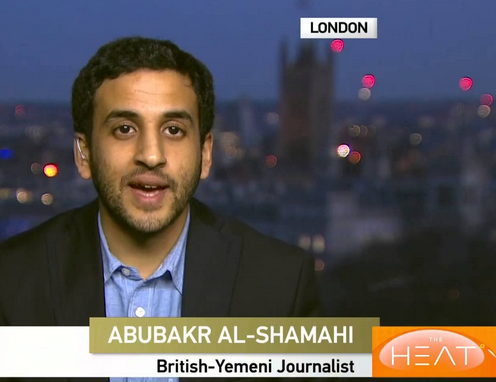
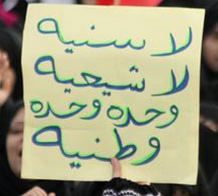

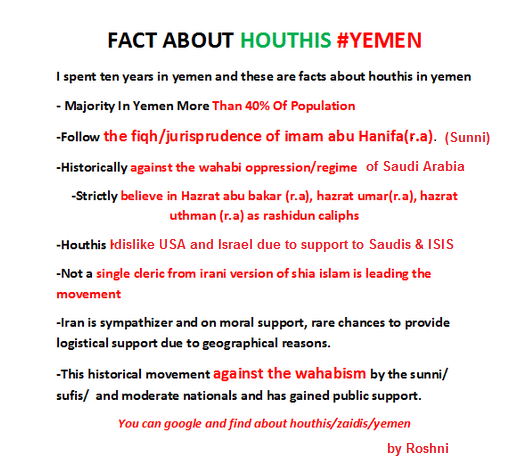


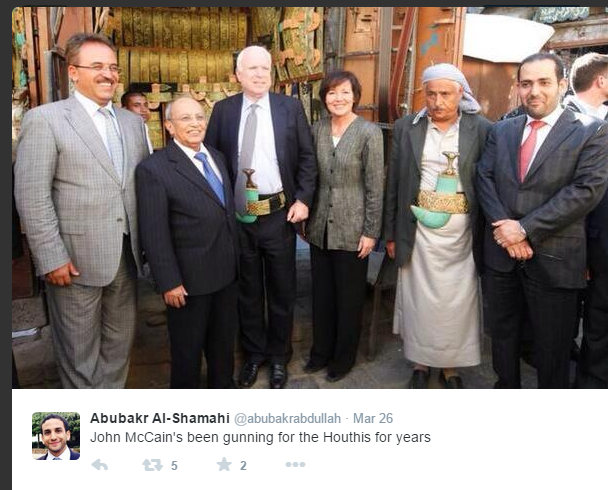
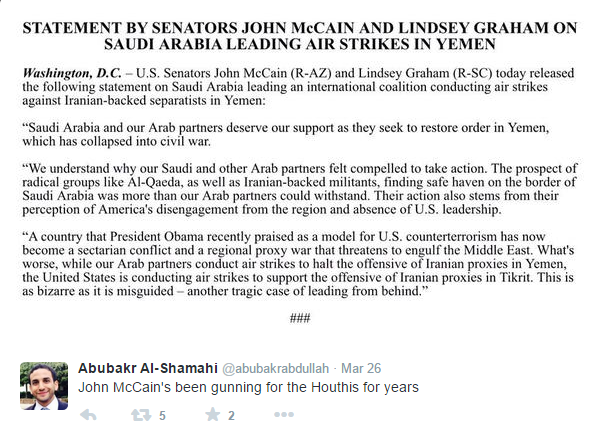
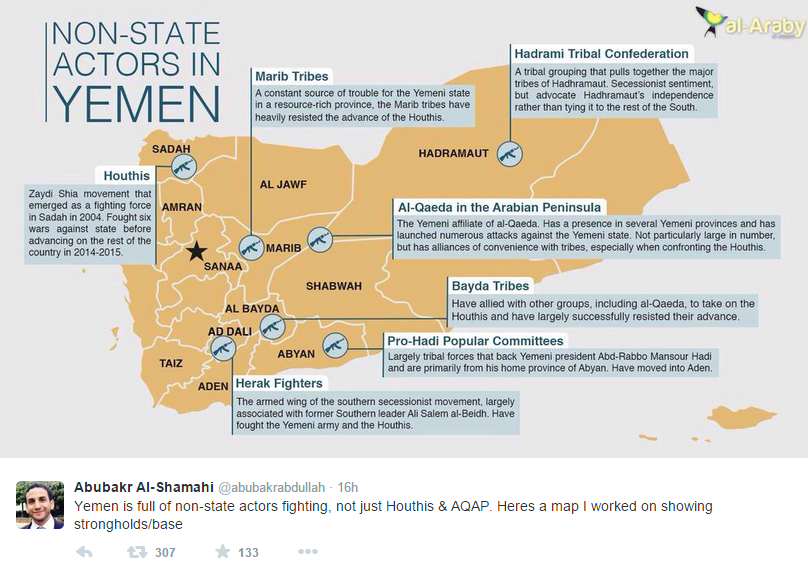
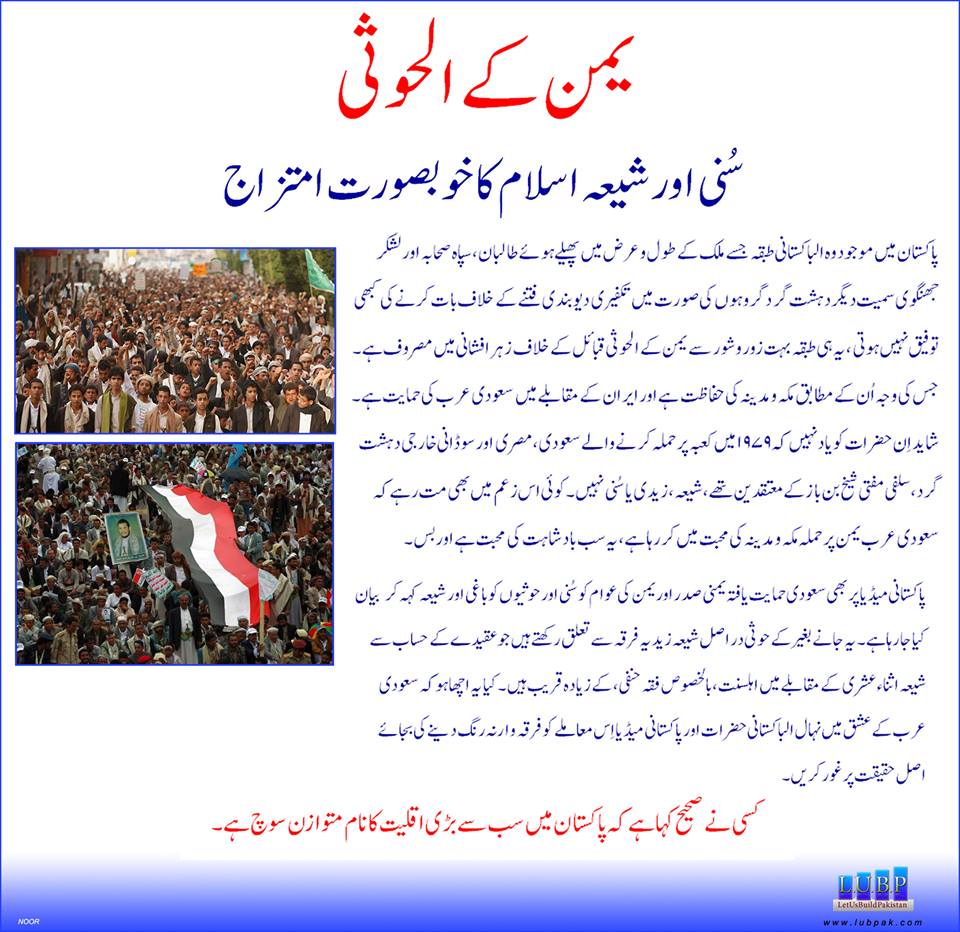
Abdul Nishapuri’s comment:
Activists: Beware of the Western and Saudi media’s false Sunni-Shia and Iran-Saudi binaries in Yemen.
Houthis are closer to Sunni Muslims (Hanafis) than they are to Shias (Twelvers).
See this thread for further information. Please spread the word and the discourse:
Khurram Zaki
کالعدم تکفیری دہشتگرد انجمن سپاہ صحابہ اور اس کے حامیوں اور ہمنوا کے خیالات کے برعکس بتاتا چلوں کے یمن میں موجود حوثی قبیلہ شیعہ اثنا عشری نہیں اور یہ حضرت ابو بکر و عمر کی خلافت کو قبول کرتے ہیں اور مذید یہ کہ اس مکتب کے بانی امام زید بن علی بن حسین کے سب سے بڑے طرفدار کوئی اور نہیں بلکہ فقہ حنفی کے بانی امام ابو حنیفہ تھے بلکہ خود امام ابو حنیفہ بھی اپنے سیاسی افکار کے اعتبار سے زیدی مکتب فکر سے تعلق رکھتے تھے
Ali Jawad
یمن میں حوثی شیعہ باغی نہیں بلکہ ملک میں انقلاب لا چکے هیں. کسی کو بلاوجہ قتل نہیں کرتے بلکہ گرفتار وزیراعظم کو رها کیا. اور باهر کی ملک نے اس پر حملہ کیا هے نہ کہ حکومت اور ریاست اسکا خلاف هے. ریاست اور ملک کی اسٹیبلیشمنٹ اور آرمی سمیت سنی عوام بهی ان کے ساتھ ساتھ ہیں. هوثی قبیلے کے اکیلے کا انقلاب نهیں بلکہ ملک کے مظلوم عوام کے ساتھ حو ثی قبلیلے والی انقلاب کی قیادت کر رهے هے. امریکی اور سعودی هی مخالف هے. یمنی عوام نهیں
Abdul Nishapuri:
Western media, takfiri Deobandis and their comrade liberals ignore that Zaidis are a version of both Sunni Hanafi and Shia Islam. They ignore it because this does not allow them to construct false Sunni-Shia or Saudi-Iran binaries. The denominations of Islam in Yemen are as follows: 35% primarily of the Sunni Shafi’i, 8% Hanafi and Maliki, 2% Salafi/Wahhabi etc. 50% of the Zaidi order of Shia/Sunni Islam, 5% of the Shia Jafari and Shia Ismaili. According to an Al-Jazeera report “Zaydis are theologically closer to Sunni Islam than they are to mainstream Twelver Shias”
Al-Hadi ila’l-Haqq Yahya, founder of the Zaydi state in Yemen, instituted elements of the jurisprudential tradition of the Sunni Muslim jurist Abū Ḥanīfa, and as a result, Zaydi jurisprudence today continues somewhat parallel to that of the Hanafis.
Ali Taj said:
Zaidis are a Sunni Shia hybrid sect, they follow Imam Abu Hanifa’s and Imam Zaid’s fiqh, and represent a beautiful fusion and pluralism of Sunni and Shia Islam. Although we may not like their anti-Semitic rhetoric, their main thrust is not anti-America or anti-Israel, it is anti Saudi Imperialistm, anti Al-Qaeda, and anti Takfiri.
Saudi Arabia and Yemen: A history intertwined
By: Abubakr al-Shamahi Date of publication: 26 March, 2015
Tags
Saudi Arabia, Yemen, Decisive Storm
Analysis: The two Arabian Peninsula countries share a border and several decades of history, with Saudi foreign policy oriented around preventing Yemen’s troubles from crossing the border.
On March 12, Houthi rebels used the heavy weapons they had recently captured from the Yemeni army to conduct military exercises right on the border with Saudi Arabia.
By the early hours of today, Saudi Arabia was conducting unprecedented bombing raids on Houthi positions in Yemen’s capital, Sanaa, and others in the Houthi stronghold in Sadah.
This act of direct Saudi military intervention in Yemen, markedly different to the use of proxies within Yemen over the past few years, shows the importance of Yemen to Riyadh, and how worried Saudi officials are about a Houthi – and in their eyes Iranian – takeover of the country.
Yemen is vital to Saudi Arabia’s security, and, in turn, that of the al-Saud ruling family. The Saudi policy in Yemen is that of containment: prevent Yemen’s troubles from crossing the border and ensure the country does not collapse – a scenario that would leave potentially millions of refugees heading for Saudi Arabia.
Balancing act
This leads to Saudi Arabia’s two foreign policy goals when it comes to Yemen:
The first is preventing any foreign power from establishing a base of influence in Yemen. The Saudis regard Yemen as their backyard, and any foreign power attempting to throw their weight around there will be regarded as a threat to Saudi national security.
This goes back to Egyptian support, under the leadership of Arab nationalist Gamal Abdel Nasser, for a republican regime in the former North Yemen in the 1960s. It was actively opposed by the Saudis, who then supported the Zaydi Shia royalists out of fears of the potential destabilising influence a neighbouring Arab nationalist presence could have tapped within the kingdom.
Iranian power in Yemen is just the latest for the Saudis to rail against, after the perceived Egyptian and Marxist “threats” in the former South Yemen.
The other foreign policy goal is to prevent a strong Yemen emerging independent from Saudi hegemony. Yemen already has a population of around 26 million, roughly the same as Saudi Arabia’s, and one that is expected to double in the coming decades.
If enough influential people are on the payroll, Riyadh will be able to dictate their actions.
Couple that with a strong military and tribal culture in Yemen, and the Saudis’ fear of their southern neighbour growing powerful in a region Riyadh dominates is within reason.
The pattern amid chaos
Saudi Arabia’s balancing act of keeping Yemen weak but ensuring that it does not collapse has led to a number of apparently divergent policies over the years.
Take the economy. During the first Gulf War, Yemen found itself on the UN Security Council, and in a disastrous move, abstained from a vote on the resolution that sought to establish an international coalition to fight Saddam Hussein’s Iraq.
That abstention was severely punished by the Saudis and other Gulf states, who moved to expel millions of Yemeni workers. With remittances from Yemeni workers accounting for around half of Yemen’s economy, and the sudden presence of such a large number of unemployed people in Yemen, the country’s economy effectively collapsed.
Yet, at the same time, the Saudis have stepped in to help the Yemeni economy. Over recent years the Saudis have injected billions of dollars into Yemen’s national budget, paying civil servants, keeping fuel flowing into the country, and ensuring that the Yemeni riyal does not plummet.
Saudi largesse has also been kind to Yemen’s tribes and various political figures. Numerous figures receive money from Riyadh – the Saudi policy has been that if enough influential people and groups are on the payroll, Riyadh will be able to dictate their actions and stop them from causing trouble.
This has backfired. Many tribes simply see the Saudis as a bank that they can tap into when they need, and these same Saudi allies have proven themselves weak and unreliable when called upon.
Weakened state
The funding of a variety of non-state actors has led to a weakening of an already vulnerable central Yemeni state. Although the tribal nature of Yemeni society is taken as a given, leaders such as President Ibrahim al-Hamdi in the 1970s were able to diminish the power of the tribes.
It was former President Ali Abdullah Saleh’s patronage networks, along with the Saudis, that led to tribal leaders having the money to battle the authority of the state.
Saudi Arabia and Yemen are two countries whose history has been intertwined ever since the birth of the modern Saudi state in 1932.
On his death bed, Ibn Saud, the founder of Saudi Arabia, is purported to have told his progeny that they should keep Yemen weak. A myth perhaps, but considering the past 80 years of Saudi policy, one that has a ring of truth.
http://www.alaraby.co.uk/english/politics/2015/3/26/saudi-arabia-and-yemen-a-history-intertwined#sthash.pwnMTsbU.dpuf
Saudi bombers pound Yemen for second night
By: AAAJ and agencies Date of publication: 26 March, 2015
Tags
Houthi, Sanaa, GCC, Aden, Arab League.
Jets attack military bases and positions around capital and near the port city of Aden, as Saudi-led coalition widens its air campaign against the Houthi movement.
A Saudi Arabian-led coalition has carried out a second night of air raids against the Houthi movement in Yemen, attacking military targets in the capital Sanaa and bases held by Houthi sympathisers in the south of the country.
Powerful explosions were reported in Sanaa on Thursday evening and raids were reported around the southern province of Aden, the bastion of Yemen’s internationally recognised president, Abd Rabbo Mansour Hadi.
Anti-aircraft fire erupted in response to what witnesses said were bombing runs on the military camp at al-Istiqbal, at Sanaa’s western entrance, and al-Samaa military base to the north of Sanaa.
Two raids targeted the large al-Anad airbase, north of Aden, which Houthi rebels seized on Wednesday, military sources told the AFP news agency. Another raid targeted a base of special forces allied with the Houthis in Qatabah, 75 miles north of Aden, local residents were quoted by the agency as saying.
Jets were also spotted flying over Abyan, mainly over the base of al-Majd army brigade, which is accused of being linked to the rebels, witnesses said.
Kafa Hashli, a journalist in Aden, told al-Araby al-Jadeed of local support for the Saudi campaign.
“There is a feeling of strength among many and a feeling that the international community has finally been fair to the south, even if it is late,” he said. “Aden was on the verge of disaster as people were preparing for urban warfare. Southerners had felt that they had been left alone.”
Aden was on the verge of disaster… [now] there is a feeling of strength among many.
Kafa Hashli, Aden
However in Sanaa, Somaya Alkorshwmi, a student, said residents feared for their lives.
“Living under Saudi air raids makes us feel that we don’t have any dignity and that the state does not have any sovereignty,” she said. “This isn’t the right way to press the Houthis. Imagine how densely populated Sanaa is, and they’re randomly bombing. I’m terrified.”
Sources in the Houthi stronghold of Sadaa, which shares a border with Saudi Arabia, reported to al-Araby al-Jadeed that jets bombed the areas of Naqaa and Marran, in addition to other Houthi strongholds in the governorate.
Raids also targeted Houthi locations in the governorate of Hajjah, which is also close to the Saudi border.
Saudi Arabia backed over campaign
Saudi Arabia received widespread regional support for its campaign on Thursday. Four GCC states – Kuwait, Bahrain, Qatar and the UAE, joined the alliance in a move they said would protect the legitimate government of Hadi and prevent regional instability. Morocco, Egypt, Sudan, Pakistan and Jordan also declared their part in the alliance.
The US and UK said they supported the action against the Houthis, who have taken over Sanaa and large areas of the country. Hadi controls areas around the southern port city Aden, where he fled in February.
Iran condemned the attacks on the Houthis, which is it accused of backing. Tehran’s foreign minister, Mohammad Zarif, said the attacks would lead to nothing but “more bloodshed and death”.
“We have always warned countries from the region and the West to be careful and not enter shortsighted games and not go in the same direction as al-Qaeda and the Islamic State group,” he said.
Sources told al-Araby that among other targets, the first night of bombing had destroyed a runway and four MIG jets at Sanaa’s main air force base.
The Houthi-controlled ministry of health said 18 civilians had been killed and 24 others were wounded in an airstrike on a neighbourhood close to the Sanaa airport lare on Wednesday evening.
Hadi, who was reported on Wednesday to have fled Yemen as Houthi fighters converged on Aden, arrived in Riyadh on Thursday and is expected to participate on Saturday in an Arab League summit in Egypt, which will discuss the war in his country and moves to create a Arab joint-military force to tackle crises in the region.
Meanwhile, sources have told al-Araby that two US navy ships are patrolling the Red Sea, across from Yemeni shores in the Bab al-Mandab strait, to monitor the situation.
The source said the USS Iwo Jima and the USS Fort McHenry, in the area since January, were on high alert.
The White House on Wednesday said it would provide information and logistical support to its GCC allies in their campaign in Yemen.
Abubakr al-Shamahi contributed to this report, which also includes translated material from our Arabic edition.
– See more at: http://www.alaraby.co.uk/english/news/2015/3/26/saudi-bombs-pound-yemen-for-a-second-night#sthash.gRM0WGFX.dpuf
بھائی جہاں سے پیسے ملینگے وہاں وہاں ہم لڑینگے
ہمارا نام بھخشو ہے.
حالانکہ یمنی ھوتی اور عبدللہ صالح ہمارے سنی بھائی ہیں
لیکن سعودیہ کی وہابی حکومت کو ان سے خطرہ ہے اس لیے
شیعہ کہہ کر سنیوں کو مارنا ایک اسلامی کام ہوگیا ہے.
آپکا منہ حیرت سے ایک بار پھر سے پھٹا کا پھٹا رہ جائیگا
جب آیندہ چند سال بعد ہم اسی سعودی حکومت کے خلاف لڑینگے
بس اس بادشاہت کی خاطر تمام اسلامی دنیا کا کبا ڑا نکل جانے دو
آپ دیکھنا پھر امریکہ بادشاہ زیادہ پیسے ہم کو دیگا
کہ سعودی بادشاہت ختم ہونی ہے ور وہاں جمہوریت آنی چاہئیے
A solution to the Yemeni conflict can’t be produced outside the country and the Saudi-led international intervention which violates the sovereignty of Yemen will only worsen the situation, political analyst Ibrahim Alloush told RT.
RT: The Arab League has agreed to create a joint military force. What does that mean? Are they preparing for a ground invasion of Yemen?
Ibrahim Alloush: I really suspect that a ground invasion is off limits right now because Yemen is a very complex situation, the terrain geographically as well as demographically is so intermingled that a ground war basically means a war of attrition. So should that happen, the war would be long, protracted and it will foment unrest within Saudi Arabia itself. Already what Saudi Arabia is doing threatens the internal stability of the country because some of the people that Saudi Arabia is fighting in Yemen have extensions and kin within Saudi Arabia.
Dr. Stephen Zunes, Middle Eastern studies professor at University of the San Francisco comments on Yemeni crisis: “There are legitimate concerns about the Houthis advance; they’ve gone well beyond what could reasonably be a considered a legitimate defense of their rights as a minority… At the same time I think the main problem with Yemen, what sparked this crisis, is that when you have that broadly based non-violent pro-democracy movement with literally millions of people on the streets demanding greater democracy and accountability, you had the Saudis with US support coming in to basically manage the transition, not including the civil society groups that work for democracy, but instead brought on by the vice president of the authoritarian president that had been overthrown… The only political solution I see is going back to square one, and include not just the elite forces of the former regime and their armed opponents and the Saudi and US appointed replacements, but the people representing the majority of the Yemenis themselves”.
Read more
Iran, Russia demand immediate halt to Saudi-led intervention in Yemen
RT: Is there a military solution to the situation in Yemen?
IA: I do not think so. There is only a political solution to the situation in Yemen. The intervention of Saudi Arabia on behalf of what it calls the legitimate government in Yemen stands against the policies of Saudi Arabia – in the past four years in Syria it was supporting the so-called rebels against the legitimate government of Bashar Assad. The same story is told all over the place as far as Saudi Arabia and other Gulf states lending support to Islamist jihadists throughout the Arab world. So that…claim that it is supporting the legitimate government stands against the very policies of Saudi Arabia. I think the political solution is the only one that could be imagined within Yemen. Such a political solution cannot be produced in Riyadh, it cannot be produced outside Yemen, it has to be a homegrown political solution, and otherwise it has no future. As we have, Hadi does not have enough strength within Yemen to tip the balance in his favor, even to stand his ground and defend his little enclave in Aden. So we need to speak about the major players in Yemen…The main players on the ground in Yemen today are not just the Houthis but also the army sections that are loyal to the former President Ali Abdullah Saleh. There are plenty within the Yemeni army – the Special Forces, the Air Force and many sectors of the military – that are still loyal to Saleh and they are the ones spearheading the fight right now against Saudi Arabia. Saudi Arabia is not only attacking the Houthis its attacking civilians as well as Yemeni troops, the legitimate Yemeni troops.
Dr. Stephen Zunes, Middle Eastern studies professor at University of the San Francisco comments on Yemeni crisis: “When it comes to democracy, human rights, when it comes to armed opposition and etc. the US, like a lot of major powers, sees it in terms of which party more represents their interests not necessarily who is legitimate and who is violating human rights.”
Read more
5 facts you need to know about Yemen and its conflicts
RT: The head of the Arab League says international intervention in Yemen will help restore Arab security. What are your thoughts on this?
IA: Well, we have seen what international intervention can do. Wherever there was an international intervention in the Arab world, such as in Libya for example in 2011 or elsewhere, basically that has led to the dismantling of the central government and the rise of sectarian strife, prolonged civilian unrest, the emergence of little enclaves controlled by al-Qaeda and ISIS and similar groups. So international intervention in fact is already underway because the US is lending logistical support to the Saudi and allied intervention in Yemen. These might be planes carrying the Saudi flag, but they are American planes, run under American command basically, under political cover from the US government. This is no different than the invasion of Libya, this is a violation of the sovereignty of another state and the US and NATO looms large in the background in this invasion.
Dr. Stephen Zunes, Middle Eastern studies professor at University of the San Francisco comments on foreign intervention in Yemen: “Whenever you have foreign intervention especially by authoritarian regimes, whenever you try to impose a solution from the outside by force it almost inevitably leads to greater instability. And again the only real hope for stability is to have a solution that includes as broad representation of the civil society as possible. Again despite the stereotypes that people often have of the Arab world, particularly in poor countries like Yemen, people there like everywhere else do want representative accountable government. They do not want to have governance imposed on them by armed factions or by foreign intervention.”
http://rt.com/op-edge/244585-yemen-conflict-saudi-arabia-intervention/
اب سمجھہ میں آیا کہ کیوں پاکستان میں شیعوں کا قتال مچایا گیا
اسی لیے کہ اگر سعودیہ اور ایران کی جنگ لگے تو پاکسان کے شیعہ
اس بات کی مخالفت کرنے کا سوچ بھی نہ سکیں کے پاکستانی فوج سعودیہ کا ساتھہ دے
حالانکہ پاکستان میں ٢٠ فیصد شیعہ ہیں . ان کی کچھ تو بات چلنی چاہئیے تھی
مگر لشکر جھنگوی نے پاکستان کے تمام شیعہ اور سنی لیڈروں کو دھمکی دیدی ہے
کے خاموش رہنا ورنہ تین صحابہ کے نام کی تین گولیاں لگینگی
مگر صحابہ کرام کے نام کا غلط استعمال کیوں کیا گیا
سینکڑوں شیعہ اور سنی ڈاکٹروں کو اسی جھوٹے الزام کے تحت مار دیا گیا
حالانکہ ان بیچارے ڈاکٹروں نے تو کوئی بے حرمتی بھی نہیں کی تھی
اب دیکھتے ہیں کے کون کون سی برکتیں ان لوگوں پے اور ان کے بچوں پے نازل ہوتی ہیں
جنہونے ان تمام ناجائز قتل کی مخالفت نہیں کی اور بس خاموش ہی رہے
ہوسکتا ہے کہ جب وہ مصیبت میں ہوں اور ان کے بچے کہیں مارے جارہے ہوں تو الله بھی ان کی دعا نہ سنے
الله بہتر جانتا ہے کے خاموش ناظرین اور گونگے تماشائیوں کی کیا سزا ہونی چاہئیے
Under the bombs: Yemenis recount tense night sheltering from airstrikes
CONFLICT Abubakr Al-Shamahi on Mar 27, 2015 @ 6:16 AM
Yemenis search for survivors in the rubble of buildings destroyed during Saudi air strikes against Houthi rebels, near Sanaa Airport, on March 26, 2015.
Mohammed Huwais AFP/Getty Images
Somaya Alkorshwmi has spent two straight nights in her basement, sheltering from the barrage of Saudi-led airstrikes that began targeting rebels in Yemen on Thursday.
Her family and neighbors joined her in her house in the capital Sanaa, as missiles rained down on the barracks nearby.
“Today the bombing started earlier and we were not as shocked and scared as yesterday, we were prepared today,” Alkorshwmi told GlobalPost by phone on Thursday evening. She added that she was nonetheless “terrified.”
Sanaa residents were awoken when the bombing first started in the early hours Thursday. The deafening booms were followed by an announcement from the Saudi Arabian ambassador in Washington that his country was leading a coalition of Arab states in an attack on Houthi rebels, who have advanced across the country and were closing in on Yemeni President Abd-Rabbo Mansour Hadi, who had fled from the capital to the port city of Aden last month.
“I went to sleep at 1:30 a.m. and woke up an hour and a half later to the sound of the bombing,” said Osamah, a Sanaa resident who did not want his full name to be used. “The sounds could be heard across the city. The anti-aircraft guns went out all across Sanaa.”
Like many in the city, Osamah woke up worried about family and friends. A few people braved going out on to the streets to bring back news that everyone he knew was safe.
“The situation in the day time was normal, people were getting along with their lives,” Osamah said.
Civilian toll
But not everyone escaped unhurt. The unprecedented foreign strikes on Yemen’s capital, as well as other targets throughout the country, left 25 people dead as of Thursday evening, according to Yemen’s Houthi-controlled Ministry of Health. Amnesty International said that toll included six children.
Many residents of Sanaa now fear of being caught in what they said appeared to be “random” bombings.
“We’re scared,” said Muhammed Abbas, a contractor. “We’ve experienced shells and they can cause damage, but missiles are different — a missile can destroy a whole neighborhood.”
The Arab coalition carrying out the bombing campaign hopes to be able to drive back Houthi fighters from Aden and weaken them in Sanaa, potentially paving the way for an extended ground campaign to rout them entirely. But it is possible that the campaign could backfire, refocusing civilian anger toward Saudi Arabia and away from the Yemeni government or the Houthi rebels.
“People don’t see this as targeting the Houthis, it is targeting Yemeni dignity,” Abbas said.
He also touched on a general anti-Saudi sentiment that is prevalent in Yemen. Many Yemenis have long felt that Saudi Arabia, Yemen’s large and powerful neighbor, too often intervenes in the poverty-stricken country for selfish reasons.
“The hatred most people have for Saudi Arabia makes people not care who’s in charge, everyone is opposed to Saudi,” Abbas said.
Hussain al-Bukhaiti, a pro-Houthi activist, said that this “hatred” for Saudi Arabia was the one thing that united Yemenis.
“I went around the city, everyone is angry. People who were against the Houthis are against the attacks,” al-Bukhaiti said, reflecting a sentiment that was expressed by anti-Houthi residents of Sanaa, like Osamah and Alkorshwmi.
Al-Bukhaiti said he hoped the Saudis would send in ground troops “because they will suffer heavy losses.”
‘I bought qat and went home’
Not everyone in Sanaa is against the airstrikes, however.
“It had to be done, someone had to deal with the Houthis and teach them a lesson,” said Amro Salman, a businessman.
“They tried negotiations and peaceful means, but they just carried on advancing.”
Salman, who said he is considering traveling to his home city of Taiz in central Yemen, spoke as bombs pounded Sanaa. He said he was enjoying an evening with his friends chewing qat, a mild narcotic popular with Yemenis.
“I went to a shopping mall for work but no one was there, so I left, bought qat, and went home.”
In Aden, Yemen’s second city on the Arabian Sea, and the center of a secessionist movement calling for the return of the once independent South Yemeni state, residents celebrated the bombings.
Aden was on the verge of being overrun by Houthi fighters and forces loyal to former President Ali Abdullah Saleh, an advance that now appears to have been rolled back.
“People celebrated with fireworks at the decision and the strikes that hit the Houthis and Saleh’s forces,” said Kafa Hashli, a journalist.
“Aden was on the verge of turning into a disaster zone as people were preparing for urban warfare, and some youth had even decided to join Al Qaeda, which has been attempting to recruit by saying that the youth had to defend their land,” she added.
Al Qaeda has attacked the Houthi Shia movement as pro-Iranian Shias, latching onto a sectarian narrative that is becoming more widespread in Yemen.
“If it had not been for this intervention the south and Aden would have been on a dangerous and chaotic path that would have benefited no one apart from Saleh, the Houthis and Al Qaeda,” Hashli said.
Arwa al-Sakkaf, a human rights activist in Aden, agreed.
“I am against any foreign intervention, but the Houthis did not give us any other choice but to seek foreign support,” al-Sakkaf said.
“The south is hurting and that hurt would have increased had the Houthis taken over. We hope that these strikes don’t stop until the Houthis and Saleh are taught a lesson.”
http://www.globalpost.com/article/6502607/2015/03/27/under-bombs-yemenis-recount-tense-night-sheltering-airstrikes
The Saudi-led military campaign against the Houthis has led to fears of a burgeoning proxy war among the Middle East’s big powers. But it is unclear how, or if, Iran will directly respond to a campaign led by a coalition of Sunni nations against a Shiite militia force. Some Middle East experts caution that the Houthi rebels are hardly puppets of Tehran, and that Iran spent years largely ignoring the group’s struggles in Yemen.
Stephen Seche, a former American ambassador to Yemen, said that the Houthis had rarely defined their struggle in Yemen in sectarian terms and that their ties to Iran had been overstated by Gulf nations.
“The Saudis and the Sunnis have made this a sectarian issue,” he said. “This military campaign is the Sunni world saying to Iran: Get out of our backyard.”
Saudi officials argue that Iran has orchestrated the Houthi military advance so they can exert influence on yet another Middle Eastern capital and destabilize Saudi Arabia’s southern border. Adel al Jubeir, the Saudi ambassador to Washington, told reporters Thursday that there was evidence that Iranian Revolutionary Guard operatives and Hezbollah fighters had embedded with the Houthis. He called the military campaign a way to protect the Yemeni people as well as “a way of protecting our national interests.” But while Saudi officials welcome American support for the Yemen operation, they are keeping a wary eye on the United States’ interactions with Iran elsewhere in the region.
Leslie Campbell, the regional director of Middle East and North Africa programs at the National Democratic Institute, said that it was hard to ignore the notion that the Saudi-led offensive in Yemen was in part a message to the United States as it negotiates a nuclear deal with Iran and finds, to some degree, common cause with Iranian-backed Shiite militias in Iraq.
The message, he said, is “if you all want to make friends with Iran, have a good time; this is what you’re going to get.”
Few disagree that the continuing tumult in the Middle East has scrambled American priorities there. This has led many to argue that the Obama administration’s policy for the region is adrift — without core principles to anchor it.
But amid the confusion, some experts said that there cannot be an overarching American policy in the Middle East at the moment. The best the White House can do, they said, is tailor policies according to individual crises as they flare up.
“I would be more concerned if we had some sort of overly rigid policy,” said Barbara Bodine, another former American ambassador to Yemen who is now the director of the Institute for the Study of Diplomacy at Georgetown University.
“It is messy. It is contradictory. That’s foreign policy.”
http://mobile.nytimes.com/2015/03/27/world/middleeast/a-policy-puzzle-of-us-goals-and-alliances-in-the-middle-east.html?_r=1
LUBP, Pakistan’s alternative media, presents a critical archive on #Yemen https://lubp.net/archives/tag/yemen #YemenUnderAttack #SaudiArabiaInvadedYemen
False Sunni-Shia binary on Yemen in mainstream media – Abubakr Al-Shamahi
[url=http://www.g58s73jmq0x9i6w3j959mwg027w51ntis.org/]uesyxokghsg[/url]
aesyxokghsg
esyxokghsg http://www.g58s73jmq0x9i6w3j959mwg027w51ntis.org/
fitflop 300 next
クロムハーツ ヘアゴム
グッチ 鞄 汚れ
ノーノーヘア パープル ワンピース
ジバンシー 赤スーツ